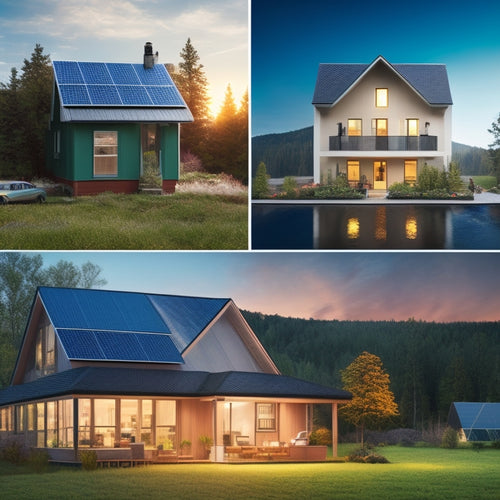
How to Upgrade Your Home With Geothermal Innovations
Share
You're now on the cusp of utilizing the Earth's natural thermal energy to revolutionize your home's heating and cooling system, thanks to state-of-the-art geothermal innovations that have rendered this eco-friendly solution more efficient, cost-effective, and accessible than ever before. Significant advances in geothermal heat exchange technology, improved drilling techniques, and precise thermal conductivity analysis have made it possible to optimize heat transfer rates and minimize energy losses. By integrating renewable energy sources, like solar energy, you can reduce grid reliance and carbon footprint. With high-performance heat pumps and smart thermostats, you'll be able to maximize energy savings and control your system with ease - and there's more to investigate about how to upgrade your home with geothermal innovations.
Key Takeaways
- Upgrade to high-performance heat pumps that convert underground thermal energy into usable heating and cooling for your home.
- Design efficient ground loop systems with carefully planned pipe layouts, sustainable materials, and optimized pipe diameters and spacing.
- Integrate renewable energy sources like solar energy to reduce grid reliance and carbon footprint, and optimize heat exchangers for maximum heat transfer.
- Install smart thermostats to enhance energy management and control, with features like remote temperature adjustments and real-time energy usage reports.
- Take advantage of federal tax credits and state incentives to offset upfront installation costs and maximize financial savings from geothermal energy systems.
Geothermal Heat Exchange Technology Advances
As you investigate the world of geothermal innovations, you'll reveal that geothermal heat exchange technology has undergone significant advances in recent years, laying the groundwork for more efficient and cost-effective home upgrades.
These breakthroughs have led to improved geothermal drilling techniques, enabling more precise and efficient installation of ground source heat pumps. Furthermore, thermal conductivity analysis has become more sophisticated, allowing for accurate assessments of soil and rock thermal properties.
In addition, incorporating renewable energy sources, such as solar energy, can further reduce reliance on the grid and carbon footprint. This understanding enables the design of optimized heat exchangers, maximizing heat transfer rates and reducing energy losses.
Efficient Ground Loop Systems Design
With enhanced heat exchangers in place, your focus shifts to designing efficient ground loop systems that can effectively harness geothermal energy. This involves carefully planning the layout and configuration of underground pipes to maximize heat transfer while minimizing costs and environmental impact.
By incorporating sustainable designs, such as those found in green energy charging infrastructure, you can reduce the system's carbon footprint and improve its overall efficiency. To achieve this, consider the following key factors:
- Using sustainable materials for pipes and fittings to reduce the system's carbon footprint
- Fine-tuning pipe diameters and spacing to guarantee efficient heat transfer and minimal pressure drop
- Designing the system for easy access and maintenance to reduce downtime and extend its lifespan
- Implementing a sturdy system maintenance schedule to guarantee peak performance and prevent issues.
High-Performance Heat Pumps Explained
Optimize your geothermal system's performance by integrating high-performance heat pumps, which play an essential role in utilizing and converting underground thermal energy into usable heat and cooling.
You'll want to choose from various heat pump types, including water-to-water, water-to-air, and hybrid models, each with its unique advantages and limitations. When selecting a heat pump, evaluate factors like your home's size, insulation, and climate to guarantee the right fit.
It's also important to evaluate the benefits of renewable energy solutions, such as reducing your carbon footprint and reliance on fossil fuels. By leveraging these sustainable options, you can create a more environmentally friendly home.
Installation considerations are also vital, as improper placement or sizing can lead to reduced efficiency and increased energy bills.
Smart Thermostats for Optimal Control
You've successfully harnessed the power of geothermal energy with a high-performance heat pump; now it's time to fine-tune your system's operation with smart thermostats.
These advanced devices allow you to optimize your home's energy management, giving you complete control over your smart home.
By implementing regular maintenance and inspections Regular Maintenance and Inspections, you can guarantee your geothermal system operates at peak performance and minimizes energy waste.
With a smart thermostat, you can:
- Remotely adjust temperature settings via mobile apps
- Create customized temperature schedules to suit your lifestyle
- Receive real-time energy usage reports to identify areas for improvement
- Integrate with other smart home devices for seamless energy management
Installing Geothermal Systems Safely
Ground-source heat pump installations require careful planning and execution to guarantee a safe and efficient operation. When you're installing a geothermal system, it's essential to prioritize geothermal installation safety.
Confirm that your installation team follows proper protocols to avoid accidents and damage to your property. You should also consider system maintenance tips to prevent equipment failure and optimize performance.
Furthermore, optimizing your solar panel array design with strategic orientation and tilt can also enhance energy production and reduce costs.
Regularly inspect your system's components, check for leaks, and clean the heat exchanger to maintain its efficiency.
Environmental Benefits of Geothermal
By incorporating geothermal innovations into your home, you'll greatly reduce your carbon footprint, contributing less to climate change and air pollution.
As a renewable energy source, geothermal energy utilizes the Earth's natural heat, providing a clean alternative to fossil fuels.
This means you'll not only minimize your environmental impact but also enjoy a sustainable, long-term solution for heating and cooling your home.
Reduced Carbon Footprint
In the pursuit of a more sustainable future, one of the most notable advantages of geothermal energy lies in its ability to drastically reduce your carbon footprint.
By utilizing the Earth's natural heat, you'll remarkably decrease your reliance on fossil fuels and lower your emissions. This means you'll be contributing less to climate change and air pollution, creating a healthier environment for you and your community.
- You'll reduce your carbon emissions by up to 75% compared to traditional HVAC systems
- Geothermal systems use eco-friendly materials, minimizing waste and environmental impact
- You'll enjoy sustainable living, free from the guilt of contributing to climate change
- With geothermal energy, you'll be joining the movement towards a cleaner, greener future
Renewable Energy Source
You're taking a significant step towards a greener home by utilizing geothermal energy, a renewable resource that's virtually limitless. Unlike fossil fuels, geothermal energy is a clean and sustainable way to power your home. Here's how it compares to other renewable energy sources:
| Renewable Energy Source | Energy Efficiency | Environmental Impact |
|---|---|---|
| Geothermal Energy | 3-4 times more efficient than traditional HVAC systems | Zero emissions, no pollution |
| Solar Energy | 15-20% efficient | Zero emissions, land requirements can be high |
| Wind Power | 45-50% efficient | Zero emissions, noise pollution can be an issue |
Cost Savings and Incentives Available
You'll be pleased to know that upgrading to a geothermal system can help you save money in several ways.
For starters, you're eligible for federal tax credits that can greatly reduce your investment costs.
Additionally, you may be able to take advantage of state incentives and lower energy bills, which can further offset the upfront costs of installing a geothermal system.
Federal Tax Credits
Twenty-six percent of the total investment in a geothermal system can be claimed as a federal tax credit, making it a significant incentive for homeowners looking to upgrade their property with this innovative technology.
This federal benefit can be a transformative opportunity for you, providing substantial savings on your tax bill. To take advantage of this opportunity, you'll need to verify your system meets the tax eligibility criteria.
Here's what you need to know:
- The tax credit applies to the total cost of the system, including installation and equipment.
- You can claim the credit for the tax year in which the system is placed in service.
- There's no upper limit on the amount of the credit you can claim.
- You can carry forward any unused credit for up to 20 years.
State Incentives Available
Beyond federal tax credits, numerous state incentives are available to further offset the cost of geothermal system installation.
You can take advantage of state programs that offer rebates, grants, or low-interest loans to homeowners who invest in geothermal energy.
Additionally, local grants and incentives may be available through your utility company or municipality.
These incentives can greatly reduce the upfront cost of installing a geothermal system.
You'll want to research the specific programs available in your state and local area to maximize your savings.
Lower Energy Bills
As you investigate the financial benefits of geothermal energy, the potential for lower energy bills becomes a significant advantage. By utilizing the natural heat of the earth, you can reduce your reliance on traditional energy sources and enjoy substantial cost savings.
Geothermal systems are incredibly energy efficient, with some systems achieving up to 4 units of energy for every unit of electricity used. This level of energy efficiency translates to lower energy bills and a reduced carbon footprint.
- Reduced heating and cooling costs by up to 70%
- Increased energy efficiency, with some systems reaching 400% efficiency
- Eligibility for federal and state tax credits, further reducing your costs
- Potential increase in your home's value due to the installation of a geothermal system
Frequently Asked Questions
Can Geothermal Systems Be Used for Cooling in the Summer?
Are you tired of sweating through summer heatwaves? Yes, you can utilize geothermal energy for cooling in the summer, enjoying geothermal cooling benefits like increased summer energy efficiency and a reduced carbon footprint, all while staying cool and free!
Are Geothermal Systems Compatible With Radiant Floor Heating?
You'll find that geothermal systems seamlessly integrate with radiant floor heating, leveraging geothermal efficiency to warm your space while reducing energy consumption, and offering a liberating freedom from traditional HVAC systems' constraints.
How Long Does a Typical Geothermal System Last?
As you envision a future of sustainable energy, you'll find that a typical geothermal system can last 20-30 years, with proper maintenance requirements like regular filter cleaning and occasional pump replacements, ensuring a long-lasting, worry-free experience.
Can I Install a Geothermal System in an Existing Home?
You can install a geothermal system in your existing home, but consider cost considerations and the installation process, which may impact system efficiency. Research zoning regulations, environmental benefits, and maintenance requirements to guarantee a seamless shift to a sustainable, cost-effective solution.
Are Geothermal Systems Noisy or Disruptive?
You'll find geothermal systems surprisingly serene, with silent underground pipes and discreet above-ground components, minimizing installation disruption and geothermal noise, so you can savor the freedom of a peaceful, eco-friendly home.
Related Posts
-

What Does Your Home Energy Audit Report Reveal?
Your home energy audit report reveals a detailed analysis of your energy consumption patterns, highlighting areas of ...
-

What Do Power Strips Do for Standby Energy?
You're likely aware that your devices, such as TVs and computers, continue to draw power even when turned off, a phen...
-

7 Top HEPA Filters for Green Building Projects
You need a reliable HEPA filter for your green building project that aligns with your sustainable goals and guarantee...


